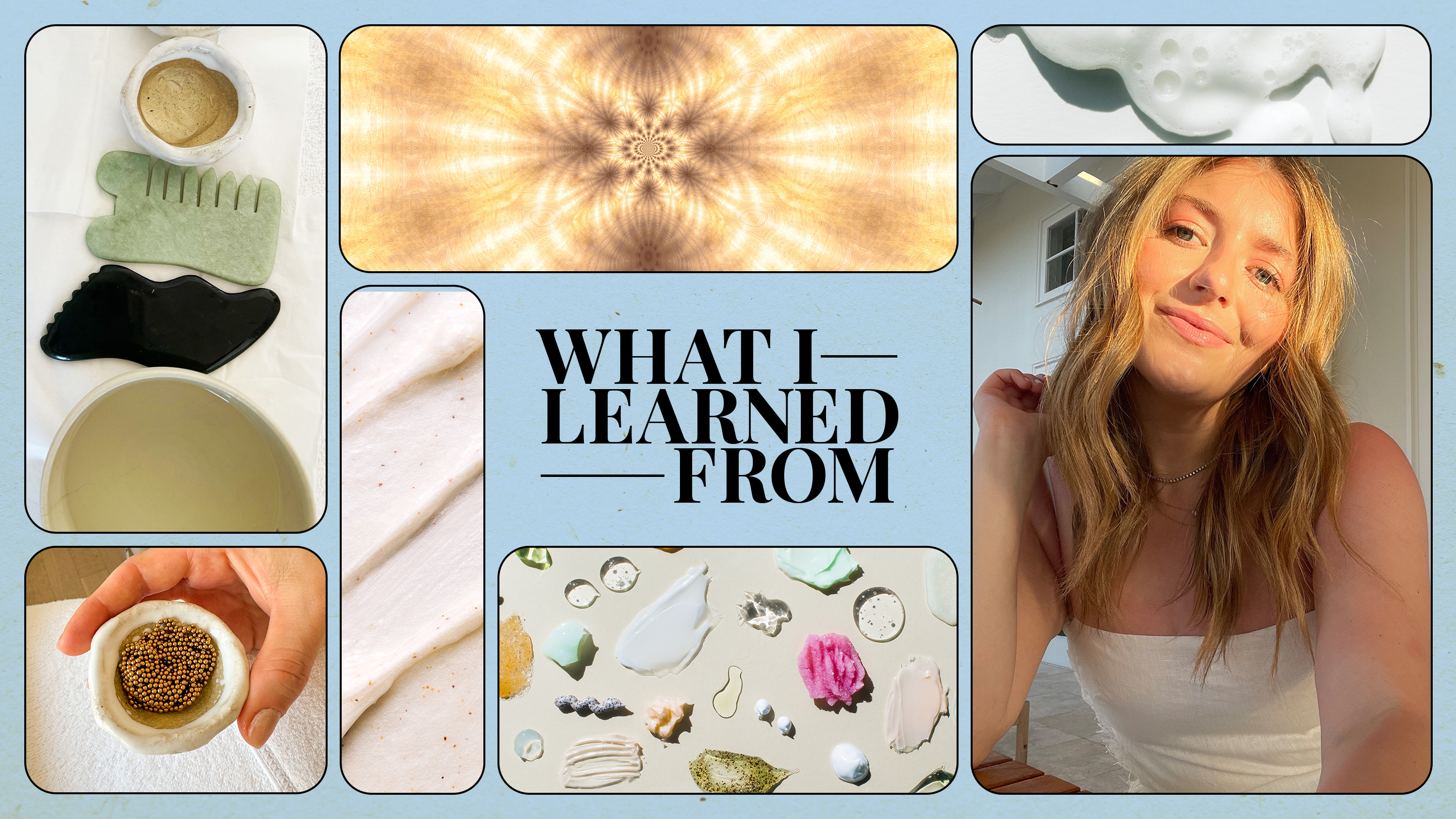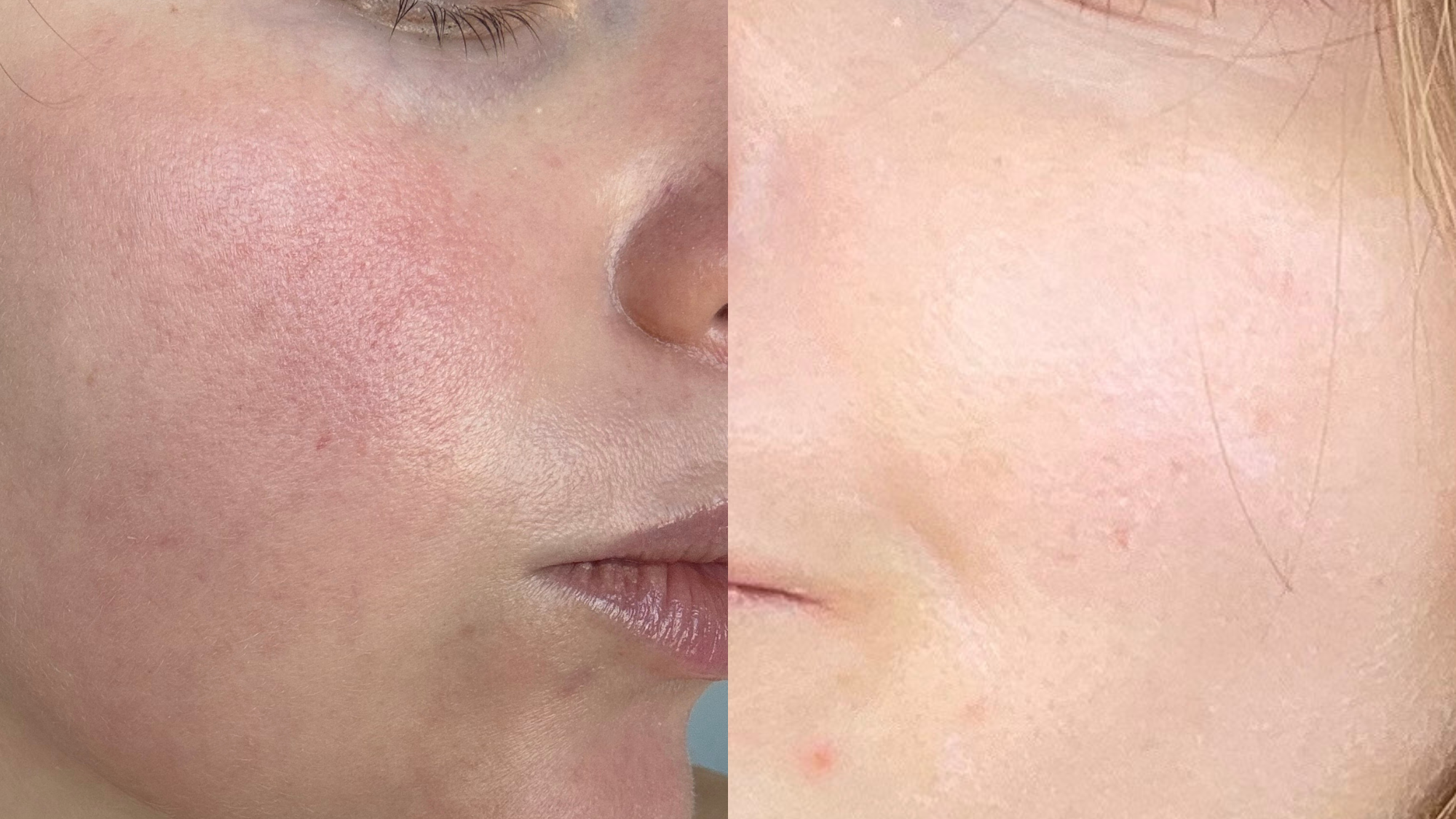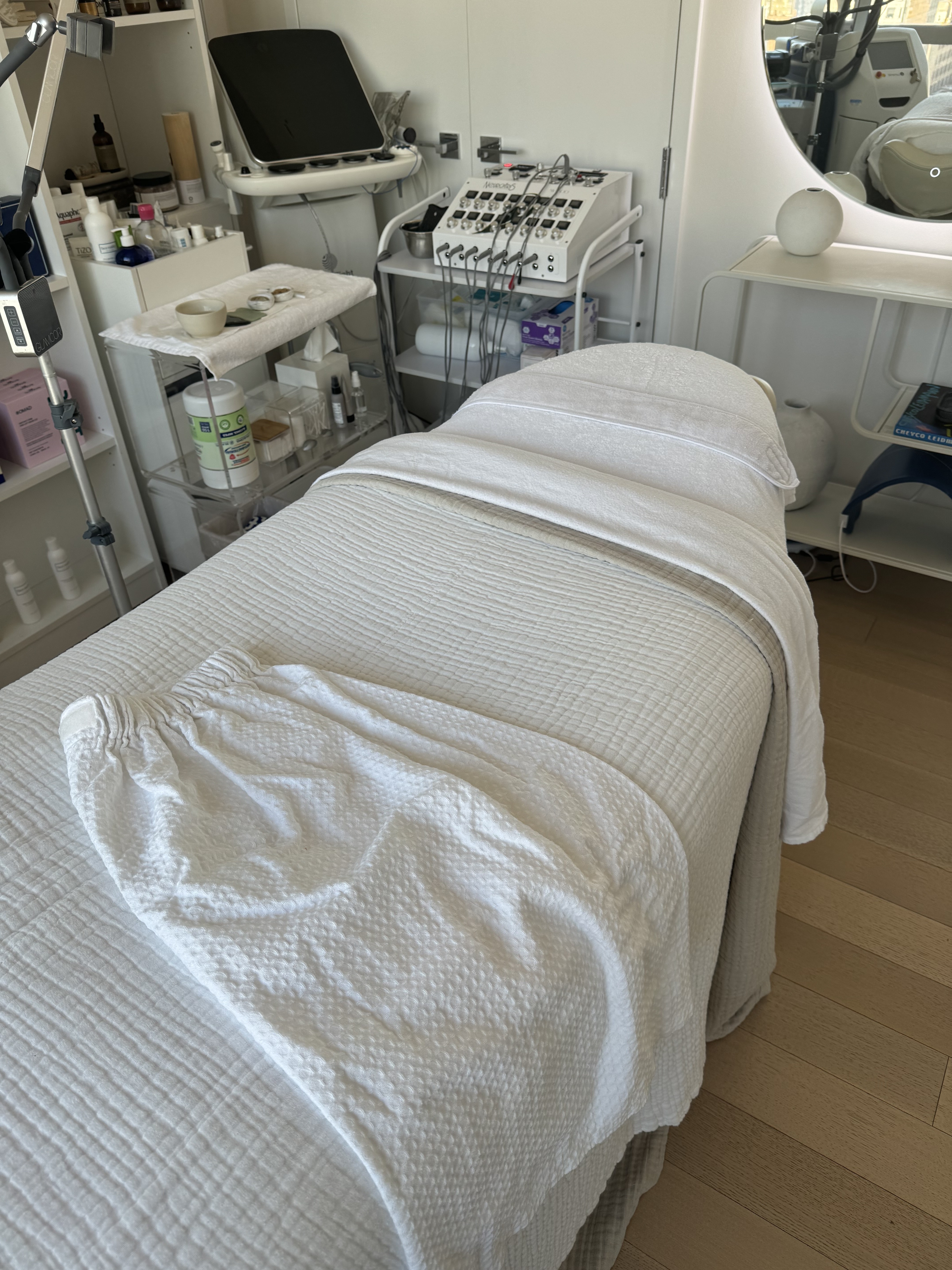I Had My Face’s Energy Field Re-Magnetized With Hundreds of Tiny Gold Beads To Soothe My Rosacea
The before-and-after photos still shock me.


Welcome to What I Learned, Maire Claire’s monthly report on the most transformative treatments, devices, and innovations in aesthetics. Here, our editors candidly share their biggest takeaways post-procedure.
I’m one of the 14 million lucky individuals to have rosacea. For the uninitiated, rosacea is a skin condition that causes redness, and, occasionally, acne-looking bumps across the cheeks, nose, and forehead. There’s no cure or explanation for why flares happen (love that, really) and the rough texture ebbs and flows. I’ve tried my best to avoid my triggers: direct sunlight, spicy foods, and my personal favorite, heat. I’ve gradually learned how to placate my often angry skin with an assortment of ice rollers, prescription creams, and even the occasional antibiotic.
Still, as a beauty editor, I will volunteer as tribute for just about any treatment that claims to be a fix—even when it sounds a little hokey. Cut to: Facialist Madalaina Conti telling me that she has gold beads from Australia that will re-magnetize my skin’s energy field and reduce my redness. Like I said: I’ll try anything.
Called Qi, the professional treatment, which combines acupuncture philosophy and the study of the skin’s static magnetic fields (more on that, below), is thought to serve as a big reset button for your skin. It’s entirely low risk, so despite my skepticism, I powered through two treatments and a few at-home touch-ups. The results were shocking. So much so, that I can’t stop staring at my before-and-after photos. Everything I learned from the treatment—including why it gave me the best sleep of my life—ahead.
The Treatment, Explained
Understanding how Qi works requires an understanding of both static magnetic fields and acupuncture.
At baseline: A static magnetic field is created when a group of magnets or charges attract a certain force. When you place a static magnetic field onto live tissue (in this case, human skin), it’s clinically proven to speed up wound healing, increase cell communication, and help repair and reset damaged skin (Just look at this 2012 clinical trial for proof).
Acupuncture on the other hand utilizes pressure points to trigger certain parasympathetic reactions. “There are three acupuncture points, the yintang, which is between the brow, conception vessel 24, which is above the lip, and governing vessel 26, which is below the lip,” explains Conti. “When you’re stimulating these three points, you’re putting the body back into the parasympathetic rest and repair mode. There are bladder points between the eyes, which can flush inflammation, there’s the stomach eight point by the hairline, which is good for lifting, or spots in front of the ears that can help with drainage.”
Get exclusive access to fashion and beauty trends, hot-off-the-press celebrity news, and more.
The so-called magic of Qi happens when the founding properties of static magnetic fields and acupuncture meet. The gold beads that make up the magnetic field are strategically placed on acupressure points to help an individual reach their skin goals.

Conti laid out all the tools, included the 24K gold magnets, she would need for the Qi treatment.
The Benefits
When the magnets have stimulated both the targeted acupressure points and created a magnetic field, the benefits of the treatment begin. “This is giving your skin a hard reset and putting it back into balance so you're actually able to repair the skin. It’s able to non-invasively perk up your cellular communication and have those cells function better,” explains Conti. “It evens out your oil secretions and water production, it builds volume, it smooths texture, and releases inflammation, which is the biggest benefit.”
The Cost
Qi isn’t necessarily a widely offered treatment—you’ll have to do some serious research to find a provider in your state. Prices will naturally vary depending on location and other modalities used during your facial, however you’re typically looking at a couple of hundred dollars. If you want a more toned down version of Qi, you can purchase an at-home kit for $160.
The Aftercare
“There's really no downtime with this,” says Conti. “The only thing I would say to avoid is a heavy duty workout where circulation will be moving through your whole body.” She also recommends sticking to simple, hydrating skincare and skipping any exfoliants for at least a few days post-treatment as the skin is extra absorbent during this time.
What I Learned
Ahead of my appointment, I did a pretty decent amount of research into acupuncture’s ability to increase skin health and static magnetic field’s connection to cell communication. The studies are there, so I genuinely wasn’t super skeptical about Qi’s efficacy. I'm a big believer in science. That being said, I know first hand how finicky rosacea can be, so despite my deep dive into medical journals galore, I remained in the believe-it-when-I-see-it camp.
That said, I’ll cut to the chase: I believe it. My biggest takeaways from the treatment, ahead.

My face was entirely covered in gold magnets, which activated the magnetic field and pushed on acupressure points.
The Treatment Itself Is an Odd Sensation
I’ve had my fair share of facials—it’s a very welcome occupational hazard. My face has been slapped, my skin has been nearly burned off, and every machine in existence has made my muscles twitch. Still, nothing is comparable to Qi. It’s entirely painless, which is a huge positive, but the pressure certainly creates a weird sensation.
It starts out pretty standard: Makeup gets removed, and then a little gentle exfoliation and facial massage comes into play. Then it's time for the Qi application. Conti first applies the Qi Beauty Intense Oil, which is soothing in its own right, to act as an adhesive for the magnets. It gets swiped on with a fan brush and then the 24-carat gold magnets are strategically placed on the skin.
I was able to feel the magnetic force forming and was acutely aware when a pressure point was activated. I’d liken the experience to that of a weighted blanket—but on your face. It takes around 15 minutes from start to finish to apply the beads, at which point they sit for roughly another 20 minutes on the skin. I wouldn’t say that I necessarily felt anything—except relaxed.
It’s Amazing for Rosacea
Qi is a generally agreeable, non-invasive facial that’s well suited for everyone, particularly those who struggle with rosacea (that would be me) and acne. I arrived at Conti’s with a pretty active flare and noticed a decrease in the redness on my cheeks directly after the treatment.
“The number one thing this is going to do is flush inflammation. If you’re struggling with redness or have an overactivity of circulation or heat in the face, it will balance it out,” says Conti. That said, the full extent of the redness reducing results will not take effect until day two or three. By then, my skin looked as even-toned and non-irritated as I can remember—and it stayed that calm for a solid month. It didn’t feel as sensitive to products or reactive to the weather. I genuinely can’t recall a time when a product or even a prescription cream had such a profound effect on my skin’s chronically red state. “It's getting your skin to be more regulated and balanced so that it has more immunity to defend and heal itself,” adds Conti.

The left photo shows the state of my rosacea before the Qi treatment, whereas the right shows the state of my rosacea directly after.
The Beads Are Gold for a Reason
I’ll be honest: At first I thought the beads were painted 24K gold purely for aesthetic reasons. It turns out, there's a purely scientific explanation. “Gold has a very high antioxidant property,” explains Conti. “So when you're placing the beads on the skin, that gold alchemy is getting transferred to the skin.” It’s that transfer that actually changes the beads from gold to copper throughout the course of the treatment.
Pro tip: Don’t throw the beads away after your treatment. Clean them, grind them up, and put them in the soil of any plants you keep at home. The nutrient-dense composition will encourage your plants to grow. “My plants grow like crazy and nothing goes to waste,” notes Conti.
It Put Me Right to Sleep
When I initially entered Conti’s studio, she informed me that I might get a little sleepy from the treatment. I didn’t think anything of it. I can power through two Benadryls need be, so a little facial wasn’t going to put me to sleep. Cut to: I was falling asleep at my desk and had the best, 12-hour night sleep. My first session, I attributed the drowsiness to a coincidence, but when exhaustion hit me like clockwork following my second treatment, I realized Conti’s word of caution was entirely legitimate.
The reason being: The yintag acupuncture point, which is targeted with gold beads positioned between the eyebrows, is famed for inducing deep relaxation, meditation, and yes, sleep.

The massage table in Conti's New York City studio that I fell asleep on.
Keep Up With Results

The at-home version of Qi features stick-on gold beads.
“You'll notice a nice reduction in redness off of the initial session, but the results are cumulative,” says Conti. “The more you do it, the more the cells are gonna repair and then the results will start to last you longer.” Ideally, you’ll have a professional treatment once a month, but you can keep up with your Qi from the comfort of your home using a take-home kit. The beads stick right onto your acupuncture pressure points. Apply the stickers to dry skin before bed and don’t take them off until morning.
I’ve been doing this at home every few days following my initial appointment and am convinced it’s extended the longevity of my results.

Samantha Holender is the Senior Beauty Editor at Marie Claire, where she reports on the best new launches, dives into the science behind skincare, and shares the breakdown on the latest and greatest trends in the beauty space. She's studied up on every ingredient you'll find on INCI list and is constantly in search of the world's glowiest makeup products. She's constantly tracking the biggest nail and hair trends to pop up in the beauty space, going backstage during fashion weeks, tracking celebrity looks, and constantly talking to celebrity hair stylists, nail artists, and makeup artists. Prior to joining the team, she worked as Us Weekly’s Beauty and Style Editor, where she stayed on the pulse of pop culture and broke down celebrity beauty routines, hair transformations, and red carpet looks. Her words have also appeared on Popsugar, Makeup.com, Skincare.com, Delish.com, and Philadelphia Wedding. Samantha also serves as a board member for the American Society of Magazine Editors (ASME). She first joined the organization in 2018, when she worked as an editorial intern at Food Network Magazine and Pioneer Woman Magazine. Samantha has a degree in Journalism and Mass Communications from The George Washington University’s School of Media and Public Affairs. While at GWU, she was a founding member of the school’s HerCampus chapter and served as its President for four years. When she’s not deep in the beauty closet or swatching eyeshadows, you can find her obsessing over Real Housewives and all things Bravo. Keep up with her on Instagram @samholender.
